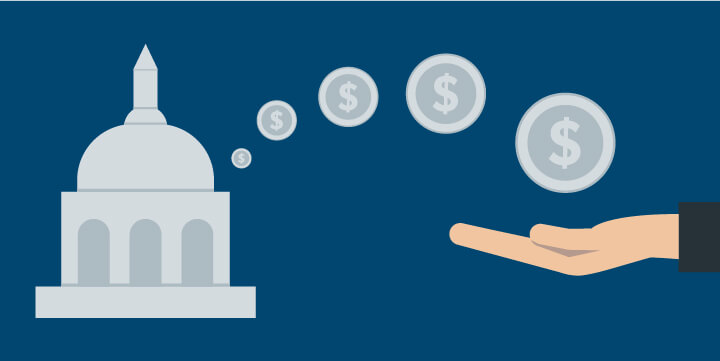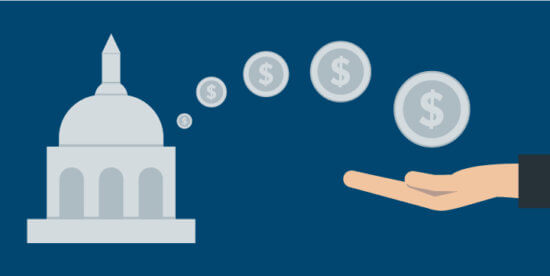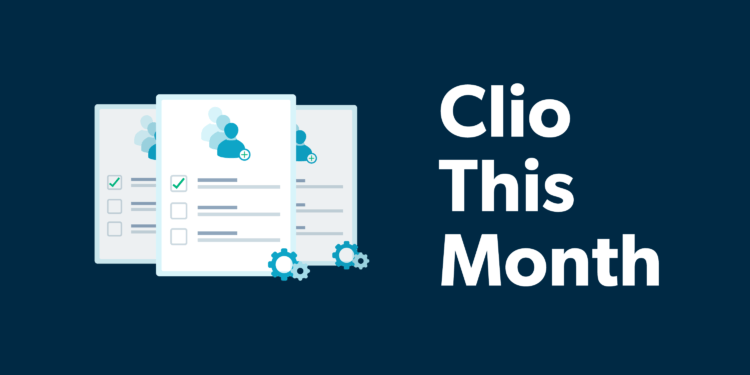***UPDATE: On April 22, 2020 a new bill that includes more than $320 billion for the Paycheck Protection Program was signed into law. With this news, it’s more important than ever to educate yourself on the program and how to apply.***
As part of the $2 trillion CARES Act, there are a number of relief programs available to help businesses across the country, including law firms. As of April 22, additional funds were added to the PPP ($310 Billion to section 1102(b)(1)), Disaster Loans Program Account ($50 Billion) and the EIDL grant (additional $10 Billion).
Here’s an overview of the stimulus options currently being managed by the Small Business Administration (SBA), along with tips for applying, and some additional coronavirus relief options law firms should consider.
Note: The programs covered in this article are changing quickly. We encourage readers to monitor relevant government websites for updates. We’ll update this article as new information becomes available.
The Paycheck Protection Program
Part of the CARES Act, the SBA’s Paycheck Protection Program is aimed at supporting small businesses who keep employees on staff during the COVID-19 crisis with loans to cover payroll and other allowable expenses.
The loan amount is calculated based on a multiple of 2.5 times your average monthly payroll costs, which are capped at $100,000 on an annualized basis for each employee, and a maximum total loan amount of $10 million. Loans have a 1% interest rate and mature in a minimum of five years for a paycheck protection loan with a remaining balance after forgiveness..
Here’s what’s notable about the program:
- Most businesses of under 500 employees will be eligible, including non-profits and sole proprietorships. Self-employed individuals, and independent contractors were also able to apply starting April 10, 2020.
- No collateral or personal guarantees are required.
- All loan payments are automatically deferred for 6 months, though the loan will continue to accrue interest during this time.
- There’s potential for the loan to be forgiven if you maintain staff and payroll. Paycheck Protection Plan (PPP) loans can also be used for rent and utilities agreements in place before February 15, 2020, and for mortgage interest obligations incurred before February 15, 2020, but it’s unlikely that more than 40% of non-payroll costs will be forgiven.
The program will be open until June 30, 2020, but businesses are encouraged to apply as soon as they can given that there’s a cap on funding, and the SBA has confirmed that the program is “first come, first served.”
With the enactment of the Payroll Protection Program Flexibility Act on June 5, the covered period for PPP loans has been extended to December 31, 2020 from June 30 2020. The forgiveness covered period (the covered period for the use of loan proceeds) has been extended to the earlier of December 31, 2020, or 24 weeks.
NOTE: You will also need to apply through your lender for forgiveness on your loan.
More detailed information about the Paycheck protection program can be found on the US Treasury website. In particular, this Information Sheet for Borrowers includes more details on applying to the program, what counts as payroll costs, conditions under which the loans may be forgiven, and more.
IMPORTANT: Remember that PPP loans only have the potential to be forgiven if you use them mainly for payroll costs. If you have few staff, but your office rent is expensive, you can use more of your PPP loan to pay rent, but it’s unlikely that a large portion of your loan will be forgiven, so you’ll need to be prepared to repay your PPP loan in a minimum of five years for a paycheck protection loan with a remaining balance after forgiveness, or seek additional funding to cover other expenses, such as one of the other options listed below.
Is it worth applying for the Paycheck Protection Program?
With a relief program of this size being deployed this quickly, there are bound to be issues, and that’s certainly true for the SBA’s Paycheck Protection Program. Several banks were not ready to start accepting applications on Friday, April 3, 2020, as planned, while some have received so many requests that they’ve closed to additional applications (even now, many lenders are likely going through their current list of applications). There were also issues with the online portal that lenders use to submit loans to the SBA.
With a tremendous-but-still-finite amount of funding available, and the SBA confirming that the program operates on a first-come, first-served basis, one might be wondering, is it worth spending the time and energy to apply now at all?
Despite the difficulties mentioned above, for most law firms with fewer than 500 employees (see below for a comment related to solo law firms specifically), the answer to the question of whether the program is worth applying for is still a resounding “yes.” The government is aware of issues with the program and is working to fix them. $310 billion in additional funding has been approved, as mentioned at the start of this article. Lenders are still accepting applications and funding is still available.
This is a massive relief program, and the largest one available to US small businesses. It’s also vital for the US economy that this money gets out to the small businesses who need it. Given the low interest rate, and the potential for loans to be forgiven if they’re used for the right reasons, it’s absolutely worth applying.
That said, it’s important to keep in mind that the scale of this program is unprecedented for the SBA, and we’d expect processing times to remain unpredictable in the near future.
You may like these posts
What about solo law firms? Is it worth applying?
The answer for solo law firms is, “it depends.” According to Gale Kirsopp, Principal at the accounting firm 4700Group and Clio Certified Consultant, “They must have a payroll. If they are a solo or independent contractor receiving 1099s from other law firms, they will need to wait until that phase of the program is released. This phase is all about firms with employees of a firm.”
Again, independent contractors were able to start applying for the program on Friday, April 10.
How to apply for a Paycheck Protection Plan Loan
It’s worth applying as soon as possible so that you’re in a good position to receive a loan once everything is running smoothly—but take enough time to make sure that all your information is correct, and that you’ve got all the supporting documents needed. You can only apply for one PPP loan. (Though, you can try to apply at more than one institution to get your loan through).
1. Finding a lender
PPP loans are being administered by banks and other lenders, not directly by the SBA, so you’ll need to apply directly to a bank for a loan.
Many banks are only allowing current customers to apply for PPP loans, citing “know your customer” rules that require banks to make sure business customers are not involved in illegal activities—the idea being that this check is onerous, and that it’s easier to process applications for existing bank customers for whom this check has already been completed.
In the short term, this might be a problem if your bank has stopped taking applications, or if you’re ready to apply and your bank hasn’t yet opened applications. In this case, one thing you may want to try is reaching out to a community bank (Jared Hecht of Fundera explains why he suggests this approach here).
2. Filling out the application and calculating payroll costs
The Paycheck Protection Plan application form is fairly straightforward, but many people are struggling to calculate their average payroll correctly.
For example, there’s been confusion resulting from the fact that the CARES Act states that average payroll should be based on the 1-year period before the date on which the loan is made, but the SBA’s Paycheck Protection Program application form states that “most Applicants will use the average monthly payroll for 2019.”
According to a guide to the CARES act from the US Senate Committee on Small Business & Entrepreneurship:
- If you were in business February 15, 2019 – June 30, 2019: Your max loan is equal to 250 percent of your average monthly payroll costs during that time period. If your business employs seasonal workers, you can opt to choose March 1, 2019 as your time period start date.
- If you were not in business between February 15, 2019 – June 30, 2019: Your max loan is equal to 250 percent of your average monthly payroll costs between January 1, 2020 and February 29, 2020.
If you took out an Economic Injury Disaster Loan (EIDL) between February 15, 2020 and June 30, 2020 and you want to refinance that loan into a PPP loan, you would add the outstanding loan amount to the payroll sum.
Lawyers may be better positioned than most to wade through the minutiae of the program. But even so, if you’re short of time, or just uncertain, we recommend reaching out to an accountant or a consultant for help, as the difference could significantly impact your loan amount depending on any changes your law firm has gone through recently.
3. Providing additional documentation
As part of the application, you’ll need to provide documentation verifying the number of full-time equivalent employees on your payroll, as well as the dollar amounts of payroll costs, covered mortgage interest payments, covered rent payments, and covered utilities for the eight-week period following the Paycheck Protection Plan loan. However, the specific documents your lender asks for may differ between institutions.
At the very least, get your payroll records, payroll tax filings, and any other tax documents you have for 2019.
Joshua Jackson of The AI Association has put together a checklist of commonly required documentation for PPP loan applications. While specific documentation asks will differ according to each lending institution, this is a great place to start, especially if you want to be prepared to apply as quickly as possible.
4. Future planning: Documenting how the money is spent
If and when you end up receiving a Paycheck Protection Program loan, in order for portions of the loan to be forgiven, you’ll need to keep track of how the money was spent so that you can prove you’ve spent it on appropriate expenses (payroll and agreements for rent, mortgage interest, and utilities entered into prior to February 15, 2020). Otherwise, you’ll need to pay back the unforgiven amounts at 1% interest within a minimum maturity of five years for a loan with a remaining balance after forgiveness.
The original use of proceeds had to be 75% of the loan on payroll, but now that has been changed to 60% of the forgiveness amount with the PPP Flexibility Act.
Attorney Adam Williams suggests the following (from an April 7 webinar put on by ServeNow): Open a separate bank account for money received through the PPP and other government programs, as this will help you keep a clear record of spending.
How do I get my PPP loan forgiven?
For a law firm or lawyer to apply for forgiveness of a Paycheck Protection Program (PPP) loan, you must complete this application as directed, and submit it to the lender that is servicing your loan.
Your law firm may also complete the application electronically through your lender. The application has the following components:
- (1) the PPP Loan Forgiveness Calculation Form;
- (2) PPP Schedule A;
- (Optional) the PPP Schedule A Worksheet; and
- (Optional) the PPP Borrower Demographic Information Form.
All Borrowers must submit (1) and (2) to their Lender.
Economic Injury Disaster Loan
**NOTE: As of Monday May 4, 2020, EIDL loans are only going to agricultural businesses**
The Economic Injury Disaster Loan (EIDL) has been offered by the SBA for many years. The main difference today is that, as part of the CARES Act, $10 billion was allocated to fund grants (the SBA is referring to these as “advances” on their website) of up to $10,000 for EIDL applicants. Another $10 billion was added to this program with the latest round of funding.
Typical processing times for EIDL loans are 3 to 4 weeks, but with surging interest in the program due to COVID-19, processing times are likely to take even longer. The grants are meant to provide faster relief to businesses that are experiencing a temporary loss of revenue.
Key details about EIDLs:
- Available for small businesses (law firms) and most non-profits in a declared disaster area (most states have declared the COVID-19 pandemic as a disaster)
- Loans of up to $2 million, with a maximum 4% interest rate and maximum 30-year term
- More difficult to qualify for, but less restrictive on spending. There is no requirement to use the funds for specific purposes, as with the Paycheck Protection Program
Key details about the CARES Act grant:
- You will not need to repay the grant, even if your loan application is rejected
- Your grant amount will be subtracted from the total loan amount issued
- Funds are meant to be received “within days of a successful application,” though interest is high and processing times remain unpredictable—many business owners are still waiting to hear if they were successful despite applying last week.
Details about the EIDL grant are constantly changing, but for now, Bench Accounting has an excellent summary of common questions about both EIDLs and the CARES Act grant.
EIDL or PPP loan?
Because of the lack of restrictions on spending, EIDLs are also suitable for law firms for whom payroll is not their largest expense. 40% of non-payroll related expenses may be forgiven for PPP loans (previously only 25% before the PPP Flexibility Act), and the term is five years (previously two years) on any non-forgiven amounts. Still, terms are much longer with EIDLs, which may be more manageable for your business.
However, as Gale notes, “the Paycheck Protection Program (PPP) has the potential to become a grant if the funds are used exclusively for the listed criteria. Other programs are a loan that will need to be repaid.” So, if there’s any chance you foresee payroll being an issue for you for the next eight weeks, it’s worth applying for a PPP loan since you may not have to pay this money back. Note that you can hire someone as an employee even for temporary work.
Take a close look at your firm’s finances to determine what’s best for you, and seek the help of an accountant, consultant, or fellow lawyer if you’re unsure.
Other Covid-19 Relief Options
While the Paycheck Protection Program and EIDL grants have received the most media attention, the SBA does have other relief initiatives to help businesses through COVID-19 that law firms may be able to take advantage of.
One of those is the Express Bridge Loan Program, which allows those with an existing business relationship with an SBA express lender to access up to $25,000. These loans can be used to further bridge the gap for businesses waiting to hear back on their EIDL applications.
Also, if your firm has an existing loan with the SBA, you should know about the SBA’s debt relief efforts. Details:
- The SBA will automatically pay the principal, interest, and fees of current 7(a), 504, and microloans for a period of six months.
- The SBA will also automatically pay the principal, interest, and fees of new 7(a), 504, and microloans issued prior to September 27, 2020.
Separate from its debt relief efforts, you can also find an investor for your business through a Small Business Investment Company (SBIC) licensed by the Small Business Administration (SBA).
Beyond those programs being run through the SBA, there are a number of other initiatives law firms may want to explore that have been set up to help both individuals and businesses through the COVID-19 crisis. Gale has put together a spreadsheet with the available options for her clients, and has generously allowed us to share it here as well.
Additional help understanding government stimulus programs
This is a difficult and unprecedented time for all law firms and businesses. If you’re feeling overwhelmed, don’t hesitate to reach out to a professional for help in understanding the process, whether it’s an accountant, consultant, or fellow lawyer.
Clio has also partnered with CPN Legal (a Clio Certified Consultant) to host weekly workshops every Thursday at 12:30pm PT / 3:30pm ET focused on US government funding programs for small businesses. They’ll discuss funding programs available, who might be eligible, how to apply, and how to comply with programs if approved. Register for a session here.
Note: The information in this article applies only to US practices. This post is provided for informational purposes only. It does not constitute legal, business, or accounting advice.
We published this blog post in April 2020. Last updated: .
Categorized in: Uncategorized






